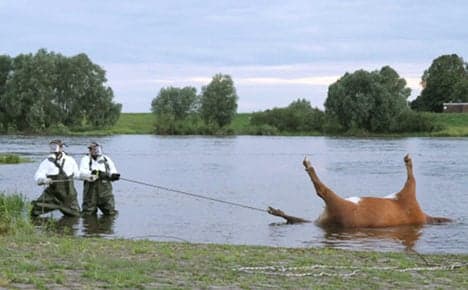Anthrax outbreak kills cows, 50 people treated

An anthrax outbreak has left at least nine cows dead and 50 people on antibiotics in eastern Germany, authorities said on Friday. Experts fear the cause was infected dead animals buried where the cows were grazing.
Police pulled one of the dead cows out of the Elbe river on Thursday. It had apparently fallen into the water after becoming separated from its 50-strong herd, which was being quarantined.
The corpse floated some distance from Saxony-Anhalt into the neighbouring state of Brandenburg, where it was finally dragged out of the river by a team clad in protective gear.
“The current of the river is so strong, that the chances of a human getting ill from going in the water are slim,” a spokeswoman for the Stendal area – where the herd was from – told The Local.
Chances of the bacteria being passed to other herds were also slim, said state vet Klaus Reimer. Transmitting the deadly spores was only possible through close contact, and the whole herd has since been isolated.
While the exact cause of the outbreak remains unknown, Heinrich Neubaue, head of the institute for bacterial infection and zoonotic diseases at the Friedrich-Loeffler Institute, said that the most common reason was animals grazing in a field where animals with anthrax have been buried.
Because anthrax spores can live for decades, there was a chance that they could make it up through the ground and into the air.
Hoofed animals such as cows, sheep and goats are particularly susceptible to the bacteria, which can cause large sores, inflammation of the throat, nose and tongue, and often sudden death.
An investigation will start on Monday to see whether dead animals are in fact buried where the affected herd grazed.
In humans, the bacteria is most commonly contracted by those who work closely with animals. Some 50 people thought to have come into contact with the cows prior to the outbreak have now been put on preventative antibiotics.
Approximately 2,000 people die of anthrax each year worldwide, according to World Health Organisation statistics. Symptoms in humans tend to be fever, swelling, discolouration of the spleen, but these can differ depending on whether a person has been infected through their skin, by breathing in spores, or ingesting them.
DPA/The Local/jcw
Comments
See Also
Police pulled one of the dead cows out of the Elbe river on Thursday. It had apparently fallen into the water after becoming separated from its 50-strong herd, which was being quarantined.
The corpse floated some distance from Saxony-Anhalt into the neighbouring state of Brandenburg, where it was finally dragged out of the river by a team clad in protective gear.
“The current of the river is so strong, that the chances of a human getting ill from going in the water are slim,” a spokeswoman for the Stendal area – where the herd was from – told The Local.
Chances of the bacteria being passed to other herds were also slim, said state vet Klaus Reimer. Transmitting the deadly spores was only possible through close contact, and the whole herd has since been isolated.
While the exact cause of the outbreak remains unknown, Heinrich Neubaue, head of the institute for bacterial infection and zoonotic diseases at the Friedrich-Loeffler Institute, said that the most common reason was animals grazing in a field where animals with anthrax have been buried.
Because anthrax spores can live for decades, there was a chance that they could make it up through the ground and into the air.
Hoofed animals such as cows, sheep and goats are particularly susceptible to the bacteria, which can cause large sores, inflammation of the throat, nose and tongue, and often sudden death.
An investigation will start on Monday to see whether dead animals are in fact buried where the affected herd grazed.
In humans, the bacteria is most commonly contracted by those who work closely with animals. Some 50 people thought to have come into contact with the cows prior to the outbreak have now been put on preventative antibiotics.
Approximately 2,000 people die of anthrax each year worldwide, according to World Health Organisation statistics. Symptoms in humans tend to be fever, swelling, discolouration of the spleen, but these can differ depending on whether a person has been infected through their skin, by breathing in spores, or ingesting them.
DPA/The Local/jcw
Join the conversation in our comments section below. Share your own views and experience and if you have a question or suggestion for our journalists then email us at [email protected].
Please keep comments civil, constructive and on topic – and make sure to read our terms of use before getting involved.
Please log in here to leave a comment.